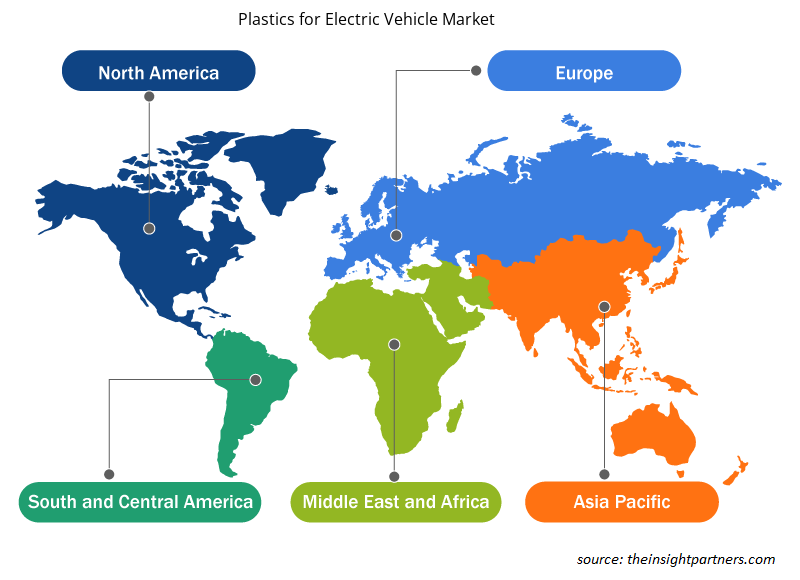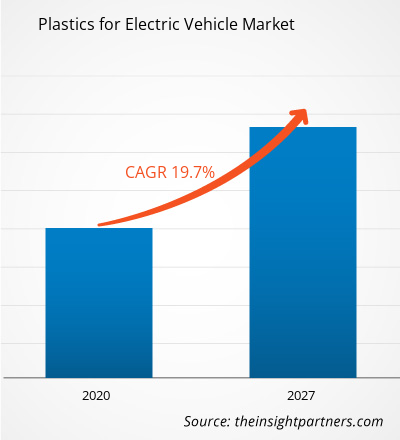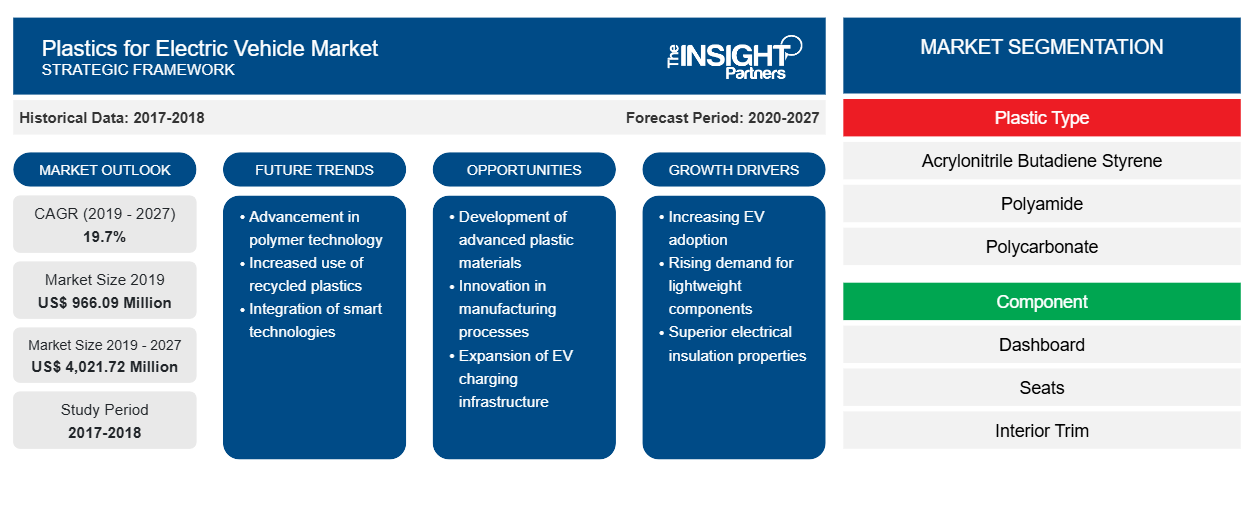전기 자동차용 플라스틱 시장 규모는 2019년에 9억 6,609만 달러였으며, 2027년까지 40억 2,172만 달러에 도달할 것으로 예상됩니다. 2020년에서 2027년까지 연평균 성장률은 19.7%일 것으로 예상됩니다.
플라스틱은 전기 도체이자 절연체일 수 있습니다. 열가소성 폴리머는 플라스틱의 높은 다재다능성과 쉬운 성형성으로 인해 전기 자동차의 요구 사항에 따라 다양한 모양과 디자인으로 생산될 수 있습니다. 전기 자동차에 플라스틱을 사용하면 이러한 차량의 무게가 줄어들어 충전 간 범위가 더 넓어집니다. 플라스틱은 배터리 칸과 냉각 시스템을 구성할 수 있는 뛰어난 내열성을 제공하며 전기 자동차가 제공하는 내구성과 안전성을 방해하지 않습니다. 북미의 전기 자동차용 글로벌 플라스틱 시장은 2020~2027년 동안 20.0%의 가장 높은 CAGR로 성장할 것으로 예상됩니다.
COVID-19 팬데믹은 2019년 12월 우한(중국)에서 처음 보고되었습니다. 2020년 6월 현재 미국, 러시아, 인도, 스페인, 브라질, 이탈리아, 프랑스, 독일은 COVID-19 양성 사례와 보고된 사망자 수 측면에서 가장 큰 영향을 받은 국가에 속합니다. 이 발병은 봉쇄, 여행 금지 및 사업 중단으로 인해 경제와 산업에 부정적인 영향을 미치고 있습니다. 화학 및 재료는 공급망 중단, 기술 이벤트 취소 및 사무실 폐쇄의 형태로 심각한 혼란을 겪고 있는 세계의 주요 산업 중 하나입니다. 중국은 글로벌 제조 허브이자 전 세계 다양한 산업의 가장 큰 원자재 공급업체이며 COVID-19 팬데믹의 가장 큰 타격을 입은 국가 중 하나이기도 합니다. 중국의 다양한 공장과 공장의 봉쇄로 인해 글로벌 공급망과 다양한 화학 및 재료 제품의 제조 및 판매가 제한되고 있습니다. 결과적으로 팬데믹의 전반적인 영향으로 전기 자동차용 플라스틱 시장의 성장이 제한되고 있습니다.
귀하의 요구 사항에 맞게 이 보고서를 사용자 정의하세요
이 보고서의 일부 또는 국가 수준 분석, Excel 데이터 팩을 포함하여 모든 보고서에 대한 사용자 정의를 무료로 받을 수 있으며 신생 기업 및 대학을 위한 훌륭한 혜택과 할인 혜택을 이용할 수 있습니다.
- 이 보고서의 주요 시장 동향을 알아보세요.이 무료 샘플에는 시장 동향부터 추정 및 예측까지 다양한 데이터 분석이 포함됩니다.
시장 통찰력
전기 자동차 수요 증가로 시장 성장 촉진
자동차 제조는 환경적 지속 가능성에 대한 강조가 커지면서 온실 가스 배출을 줄이고 연료 효율을 높이는 방향으로 전환되고 있습니다. 비용 효율성, 환경적 지속 가능성, 편의성, 첨단 기술 도입, 우대 요금, 장비 구매에 대한 인센티브, 상당한 할인과 같은 다양한 정부 정책은 전 세계적으로 전기 자동차에 대한 수요를 촉진하는 요인 중 일부입니다. IEA에 따르면 2019년 전 세계적으로 210만 대의 전기 자동차가 판매되어 40%의 연간 증가를 기록했으며, 2018년을 크게 넘어섰습니다.
플라스틱 타입 통찰력
플라스틱 유형을 기준으로 전기 자동차용 플라스틱 시장은 아크릴로니트릴 부타디엔 스티렌(ABS), 폴리아미드(PA), 폴리카보네이트(PC), 폴리비닐 부티랄, 폴리우레탄(PU), 폴리프로필렌(PP) 및 기타로 세분화됩니다. 폴리프로필렌(PP) 세그먼트는 2019년에 시장에서 가장 큰 점유율을 차지했습니다. 폴리프로필렌(PP)은 프로필렌 단량체를 결합하여 생산되는 열가소성 "부가 중합체"를 말합니다. 단단하고 결정질이므로 포장 트레이, 의료 기기 등과 같은 물체를 만드는 데 널리 사용됩니다. 중요한 폴리올레핀 수지 계열 중 하나로서 유연성, 강인함, 경량성 및 내열성이 필요한 모든 유형의 플라스틱으로 성형 및 압출됩니다.
구성 요소 통찰력
구성 요소를 기준으로 전기 자동차용 플라스틱 시장은 대시보드, 시트, 내부 트림, 자동차 실내장식, 범퍼 등으로 세분화됩니다. 내부 트림 세그먼트는 2019년 시장에서 가장 큰 점유율을 차지했습니다. 전기 자동차의 내부 트림은 캐빈 내부에 있는 플라스틱 구성 요소 또는 패널을 말합니다. 기능적이고 미적인 트림과 즐거운 기능은 완벽한 실내 경험을 제공하는 데 필수적입니다.
차량 유형 통찰력
차량 유형에 따라 전기 자동차용 플라스틱 시장은 BEV와 PHEV/HEV로 나뉩니다. BEV 세그먼트는 2019년 시장에서 가장 큰 점유율을 차지했습니다. 배터리 전기 자동차 또는 BEV는 대용량 배터리 팩으로 전기를 저장합니다. 배터리의 전력은 전기 모터와 기타 전자 장치를 구동하는 데 사용됩니다. 플라스틱은 전기 자동차에 필요한 전기 구성품의 커넥터와 하우징을 만드는 데 사용됩니다.
애플리케이션 인사이트
전기 자동차용 플라스틱 시장은 응용 분야별로 파워트레인 시스템/보닛 아래, 외장, 내장, 조명 및 전기 배선으로 세분화됩니다. 내장 세그먼트는 2019년 시장에서 가장 큰 점유율을 차지했습니다. 고성능 플라스틱은 전기 자동차에 사용되어 안전과 보안을 제공합니다. 폴리프로필렌은 가스 캔 및 내부 바닥의 카펫 섬유와 같은 자동차 부품에 자주 사용됩니다. PVC는 매끄러운 마감 처리로 인해 자동차 탱크와 대시보드에 사용됩니다. 스티어링 휠과 대시보드도 아크릴로니트릴 부타디엔 스티렌 또는 ABS 플라스틱으로 생산됩니다. 스티어링 휠, 내부 바닥 및 콘솔에 플라스틱을 광범위하게 적용하면 내부 트림 세그먼트의 전기 자동차용 플라스틱 시장이 성장하는 데 유리합니다.
전기 자동차용 플라스틱 시장 지역 통찰력
Insight Partners의 분석가들은 예측 기간 동안 전기 자동차용 플라스틱 시장에 영향을 미치는 지역적 추세와 요인을 철저히 설명했습니다. 이 섹션에서는 북미, 유럽, 아시아 태평양, 중동 및 아프리카, 남미 및 중미의 전기 자동차용 플라스틱 시장 세그먼트와 지리에 대해서도 설명합니다.

- 전기 자동차용 플라스틱 시장에 대한 지역별 특정 데이터 얻기
전기 자동차용 플라스틱 시장 보고서 범위
| 보고서 속성 | 세부 |
|---|---|
| 2019년 시장 규모 | 9억 6,609만 달러 |
| 2027년까지 시장 규모 | 4,021.72백만 달러 |
| 글로벌 CAGR (2019-2027) | 19.7% |
| 역사적 데이터 | 2017-2018 |
| 예측 기간 | 2020-2027 |
| 다루는 세그먼트 | 플라스틱 종류별
|
| 포함된 지역 및 국가 | 북아메리카
|
| 시장 선도 기업 및 주요 회사 프로필 |
|
전기 자동차 시장 참여자용 플라스틱 밀도: 비즈니스 역학에 미치는 영향 이해
전기 자동차용 플라스틱 시장은 소비자 선호도의 변화, 기술 발전, 제품의 이점에 대한 인식 증가와 같은 요인으로 인해 최종 사용자 수요가 증가함에 따라 빠르게 성장하고 있습니다. 수요가 증가함에 따라 기업은 제품을 확장하고, 소비자의 요구를 충족하기 위해 혁신하고, 새로운 트렌드를 활용하여 시장 성장을 더욱 촉진하고 있습니다.
시장 참여자 밀도는 특정 시장이나 산업 내에서 운영되는 회사나 기업의 분포를 말합니다. 주어진 시장 공간에 얼마나 많은 경쟁자(시장 참여자)가 존재하는지 그 규모나 총 시장 가치에 비해 나타냅니다.
전기 자동차용 플라스틱 시장에서 활동하는 주요 기업은 다음과 같습니다.
- 바스프 SE
- 솔베이 SA
- 듀폰 드 네무어 주식회사
- 다우 케미컬 컴퍼니
- 엘지화학(주)
면책 조항 : 위에 나열된 회사는 어떤 특별한 순서에 따라 순위가 매겨지지 않았습니다.

- 전기 자동차용 플라스틱 시장의 주요 주요 업체 개요를 알아보세요
스포트라이트 보고서
- 전기 자동차용 글로벌 플라스틱 시장의 진보적 산업 동향은 플레이어가 효과적인 장기 전략을 개발하는 데 도움이 됩니다.
- 선진국과 개발도상국 시장에서 채택한 사업 성장 전략
- 2017년부터 2027년까지 전기자동차용 플라스틱 시장의 정량적 분석
- 전 세계 다양한 산업에서 전기 자동차용 플라스틱 수요에 대한 추산
- 시장에서 활동하는 구매자와 공급자의 효율성을 보여주기 위한 PEST 분석
- 전기 자동차용 플라스틱에 대한 경쟁 시장 상황과 수요를 이해하기 위한 최근 동향
- 시장 동향 및 전망, 시장 성장을 주도하고 제한하는 요인
- 전기 자동차용 글로벌 플라스틱 시장 성장을 뒷받침하는 전략에 대한 이해는 이해관계자의 의사 결정에 도움이 됩니다.
- 전기자동차용 플라스틱 시장 규모는 시장 각 노드별로 나타남
- 시장의 세부적인 개요 및 세분화, 산업 역학
- 다양한 지역의 전기 자동차용 글로벌 플라스틱 시장 규모는 이들 지역에서 유망한 성장 기회를 가지고 있습니다.
전기 자동차용 플라스틱 시장, 플라스틱 유형별
- 아크릴로니트릴 부타디엔 스티렌
- 폴리아미드
- 폴리카보네이트
- 폴리비닐부티랄
- 폴리우레탄
- 폴리프로필렌
- 기타
전기 자동차용 플라스틱 시장, 구성 요소별
- 계기반
- 좌석
- 내부 트림
- 자동차 실내장식
- 범퍼
- 기타
전기 자동차용 플라스틱 시장, 차량 유형별
- 베브(BEV)
- 플러그인 하이브리드
전기 자동차용 플라스틱 시장, 용도별
- 파워트레인 시스템/보닛 아래
- 외부
- 내부
- 조명 및 전기 배선
회사 프로필
- 바스프 SE
- 솔베이 SA
- 듀폰 드 네무어 주식회사
- 다우 케미컬 컴퍼니
- LG화학 주식회사
- 랑세스 AG
- 사빅
- 코베스트로 AG
- 아사히카세이 주식회사
- Lyondellbasell Industries Holdings BV
- 과거 분석(2년), 기준 연도, CAGR을 포함한 예측(7년)
- PEST 및 SWOT 분석
- 시장 규모 가치/거래량 - 글로벌, 지역, 국가
- 산업 및 경쟁 환경
- Excel 데이터세트
최근 보고서
관련 보고서
사용 후기
구매 이유
- 정보에 기반한 의사 결정
- 시장 역학 이해
- 경쟁 분석
- 고객 인사이트
- 시장 예측
- 위험 완화
- 전략 기획
- 투자 타당성 분석
- 신흥 시장 파악
- 마케팅 전략 강화
- 운영 효율성 향상
- 규제 동향에 발맞춰 대응





















 무료 샘플 받기 - 전기 자동차 시장용 플라스틱
무료 샘플 받기 - 전기 자동차 시장용 플라스틱